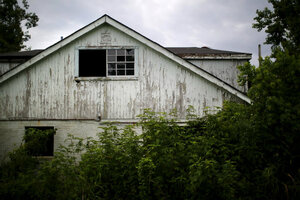Ten years after Katrina, blight remains amid recovery in New Orleans
The last decade has seen progress in key areas for the city’s residents and its infrastructure – but full recovery remains a challenge.

An abandoned house after Hurricane Katrina is seen in the Lower Ninth Ward neighborhood of New Orleans, La., Aug. 18. In 2005, Hurricane Katrina triggered floods that inundated New Orleans and killed more than 1,500 people as storm waters overwhelmed levees and broke through flood walls. Congress authorized spending more than $14 billion to beef up the city's flood protection after Katrina and built a series of new barriers that include manmade islands and new wetlands.
Carlos Barria/Reuters
Ten years after hurricane Katrina devastated southern Louisiana, recovery continues in New Orleans and along the Gulf Coast.
The worst-hit districts, still bearing the marks of disaster, remain blighted, run-down, and lined with abandoned houses that pose safety hazards to children and other residents. The people themselves are still affected, as well – New Orleans has one of the highest rates of youth unemployment in metro areas around the country, according to USA Today.
Yet the last decade has also brought hope and change to many communities hit hard by the tragedy. New Orleans residents today report seeing progress in key areas, including repairing the levees, attracting businesses and jobs, and improving medical and public transport services, a Kaiser Family Foundation poll found.
“I think despite all the underlying concerns, we see a lot of hope and a sense of resiliency,” Liz Hamel, the foundation’s director of public opinion and survey research, told NPR. “A majority now say the city has mostly recovered from the hurricane.”
Part of that progress has to do with rebuilding public confidence in resident safety as much as in rebuilding the city’s infrastructure, locals say.
“I never worried about flooding before Katrina, but after the storm, we had to ask whether it made sense, financially, to come back," Angele Givens told Reuters. In Katrina’s wake, Congress authorized spending more than $14 billion to bolster the city's existing flood protection infrastructure.
Billions also went into development efforts by the US Army Corps of Engineers: reinforcing 350 miles of levees, upgrading 70 pumping stations, and building a massive surge barrier – a nearly two-mile-long concrete wall that stretches across the convergence of three major waterways that connect to the Gulf of Mexico.
The recent work has made New Orleans and the surrounding metropolitan area “better protected than they ever have been,” Chip Kline, who chairs the Louisiana Coastal Protection and Restoration Authority, told Reuters.
Entire blocks have also been rebuilt and renovated, and the world-famous French Quarter is abuzz with tourists, drawing businesses and gentrifying neighborhoods.
But challenges remain, many of them dating back before Katrina and exacerbated by the hurricane.
Amid the restored and remodeled houses, for instance, large swaths of blight remain. “Ten years after Katrina, many New Orleans residents struggle to find an affordable place to live even though the city is full of vacant properties,” The Atlantic reports.
There also exists a racial and socio-economic divide in how residents view recovery. Half of the city’s whites say the quality of life in their community is better today, while nearly half of blacks say it’s worse, a survey by the Louisiana State University’s Public Policy Lab found. Only 37 percent of African Americans say the state has mostly recovered, compared with 78 percent of whites.
And while part of that shift has to do with the populations that returned to New Orleans after the hurricane – the LSU study found that those who came back tended to be wealthier, white, and college-educated – the disparity reflects the ground that the city still needs to cover to bounce back from disaster.
“Look, there are some gains, there are real gains,” Andre M. Perry, an education consultant who came to the city after Katrina, told The New York Times. “But this 10th anniversary in so many ways is dangerous. I think a lot of people are saying ‘Look at what we’ve done,’ as if the work is finished, and we’re nowhere near finished.”
This report includes material from Reuters.

